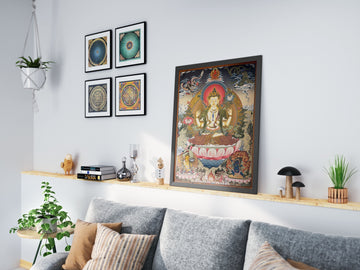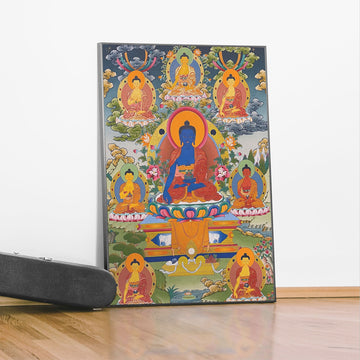Thangka paintings are far more than stunning examples of Tibetan art—they’re visual scriptures packed with symbolic meaning aimed to inspire, teach, and guide spiritual practice. But for those unfamiliar with the tradition, much of that visual language remains concealed. In this post, we’ll help you uncover the deeper meanings behind some of the most important symbols found in thangka paintings.
🧘 What is a Thangka?
A thangka (also spelled tangka or thankga) is a traditional Tibetan scroll painting used for meditation, ceremonial display, and teaching. These sacred artworks often depict Buddhas, bodhisattvas, mandalas, and mythical deities, rendered in intricate detail using vibrant mineral pigments.
🎨 The Symbolism within Thangka Art
1. Color Psychology in Thangka
Each color carries specific symbolic significance in Tibetan Buddhism. These aren't just design choices—they’re spiritual codes:
- White – Purity, peace, and detachment (e.g., White Tara)
- Red – Power, passion, compassion, and desire (e.g., Amitabha)
- Blue – Wisdom, infinite space, healing, and calm (e.g., Akshobhya, Medicine Buddha)
- Green – Activity, balance, growth, nature (e.g., Green Tara)
- Yellow / Gold – Abundance, teaching, nourishment, grounded energy (e.g., Ratnasambhava)
- Black – Transformation, wrathful energy, destruction of evil (e.g., Mahakala)
- Orange – Enlightenment, discipline, and illumination (e.g., Guru Rinpoche’s robes)
Tip: Next time you view a thangka, focus on the dominant colors—they reflect the spiritual essence of the figure.
2. Mudras (Hand Gestures)
Mudras are symbolic hand gestures used by Buddhas and bodhisattvas to express spiritual truths:
- Bhumisparsha Mudra – “Earth-touching”; calls the Earth to witness enlightenment
- Dhyana Mudra – Meditation, inner balance, concentration
- Abhaya Mudra – Fearlessness, reassurance, protection
- Varada Mudra – Charity, compassion, offering blessings
- Dharmachakra Mudra – Teaching and turning the Wheel of Dharma
- Vitarka Mudra – Discussion, explanation, transmission of knowledge
- Karana Mudra – Expelling demons, removing obstacles
- Uttarabodhi Mudra – Enlightenment and universal oneness
- Anjali Mudra (Namaskara) – Greeting, prayer, and devotion
- Jnana Mudra – Knowledge and wisdom
- Tara Mudra – Specific to Green Tara; readiness to help and protect
3. The Lotus Flower
The lotus symbolizes spiritual purity and awakening. It grows from the mud (samsara) yet blooms untouched by it—just like a practitioner on the path to enlightenment.
- White Lotus – Spiritual perfection and mental purity
- Red Lotus – Pure heart, compassion, love
- Blue Lotus – Wisdom and knowledge
- Pink Lotus – Historical Buddha, supreme enlightenment
- Gold Lotus – Complete enlightenment and universal achievement
4. Animals in Thangka Art
These sacred creatures are more than decorative—they are guardians and guides on the spiritual journey:
- Snow Lions – Joy, courage, fearlessness, Tibet’s national symbol
- Elephants – Strength, patience, mental fortitude
- Garudas – Swift wisdom, obstacle removal, mastery over poison
- Deer – Peace, receptiveness, setting of Buddha’s first teachings
- Tigers – Confidence, grounded power
- Peacocks – Transformation of poison into beauty and wisdom
- Dragons – Enlightened speech, power, protection
- Mythical Creatures – Makara, Kirtimukha: threshold guardians, spiritual tests
🛕 Mandalas: Cosmic Maps
Mandalas are visual representations of the universe—a sacred palace for meditation. They are used as tools to aid focus, visualize deities, and symbolize the mind’s journey toward realization.
- Geometric Precision – Represents balance and harmony in the cosmos
- Central Deity – Surrounded by symbolic gates, guardians, and inner circles
- Five Elements – Earth, water, fire, air, space
- Four Directions – Aligned with Buddhas and cardinal energies
- Kalachakra Mandala – Advanced symbol of time and cycles
🙏 Why Understanding Symbols Matters
When you decode the visual language of a thangka, your relationship with the art deepens. It becomes more than just beauty—it becomes a gateway to:
- 🧠 Spiritual insight
- 🌍 Cultural understanding
- 🧘 Personal meditation and growth
- 🔁 Connection with universal archetypes
🛍️ Where to Find Authentic Thangkas
At Crafts of Tibet, we source our thangkas directly from skilled Tibetan artisans—many of whom preserve traditional techniques passed down through generations. Explore our curated collections:
🧭 Conclusion
Thangka paintings are living scriptures—every brushstroke has purpose. By learning to read their symbolic language, we connect more deeply with Tibetan spirituality and universal truths. Next time you gaze upon a thangka, let it speak to you—you might be surprised by what you hear.
Want to dive deeper?
Check out our Guide to Tibetan Buddhism or explore our Wholesale Thangka Collection to bring sacred art into your space.




